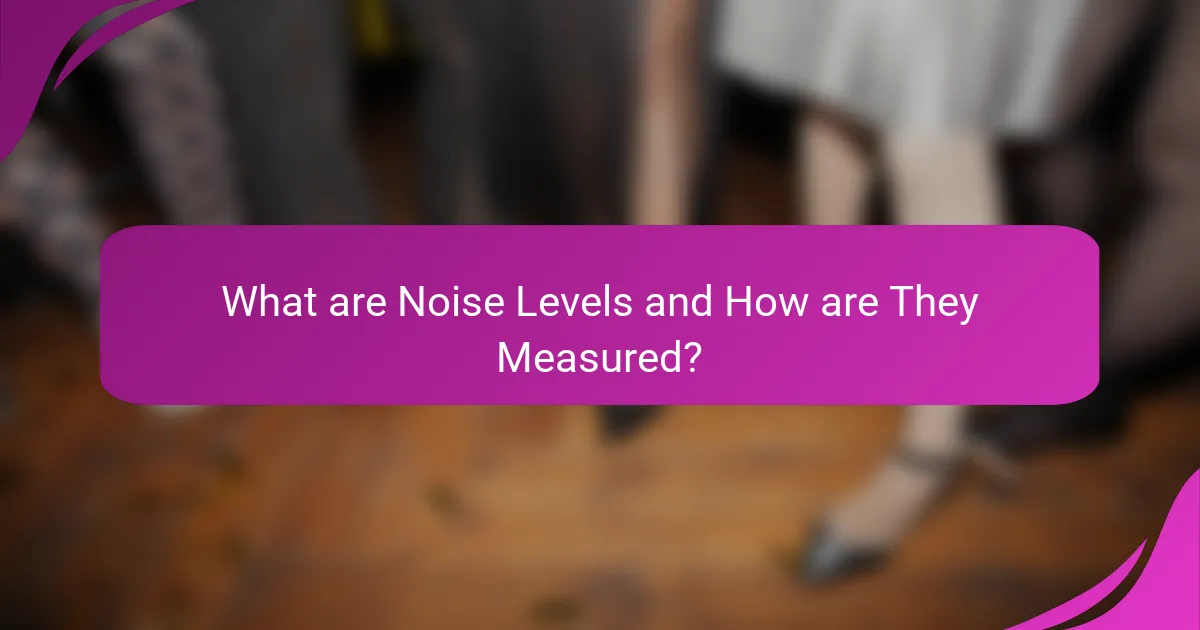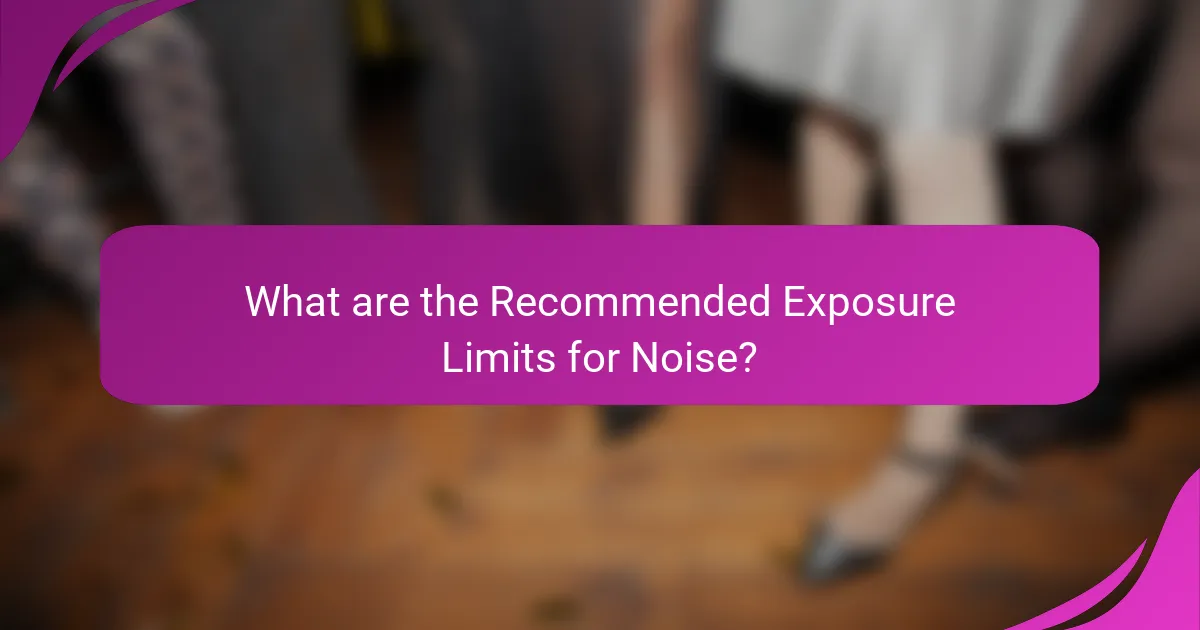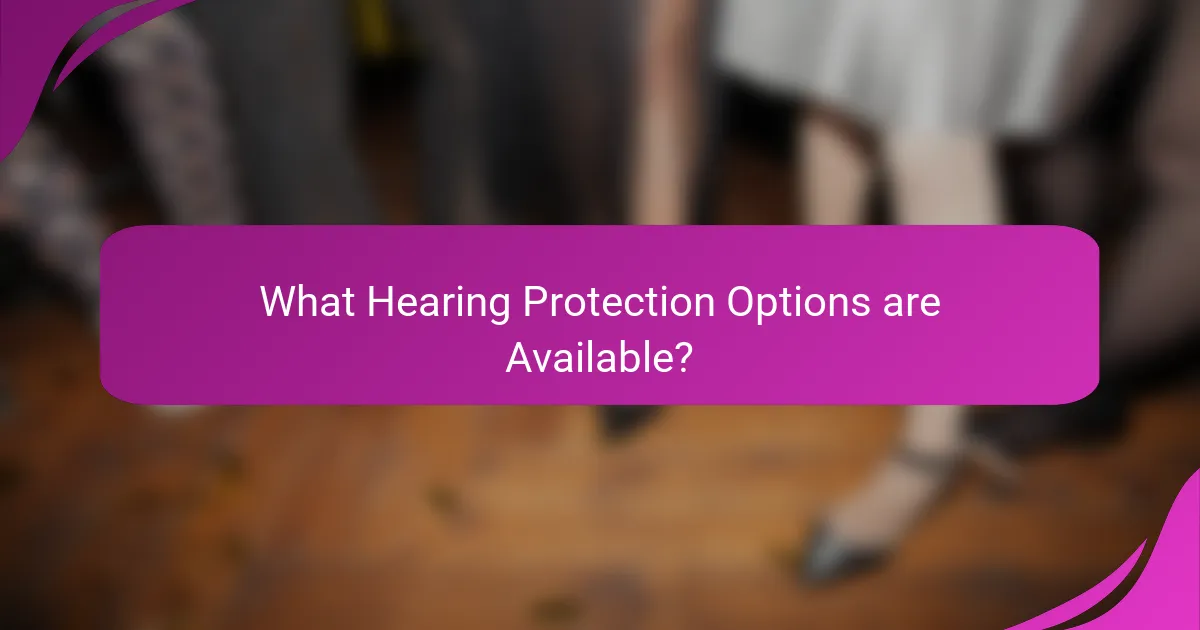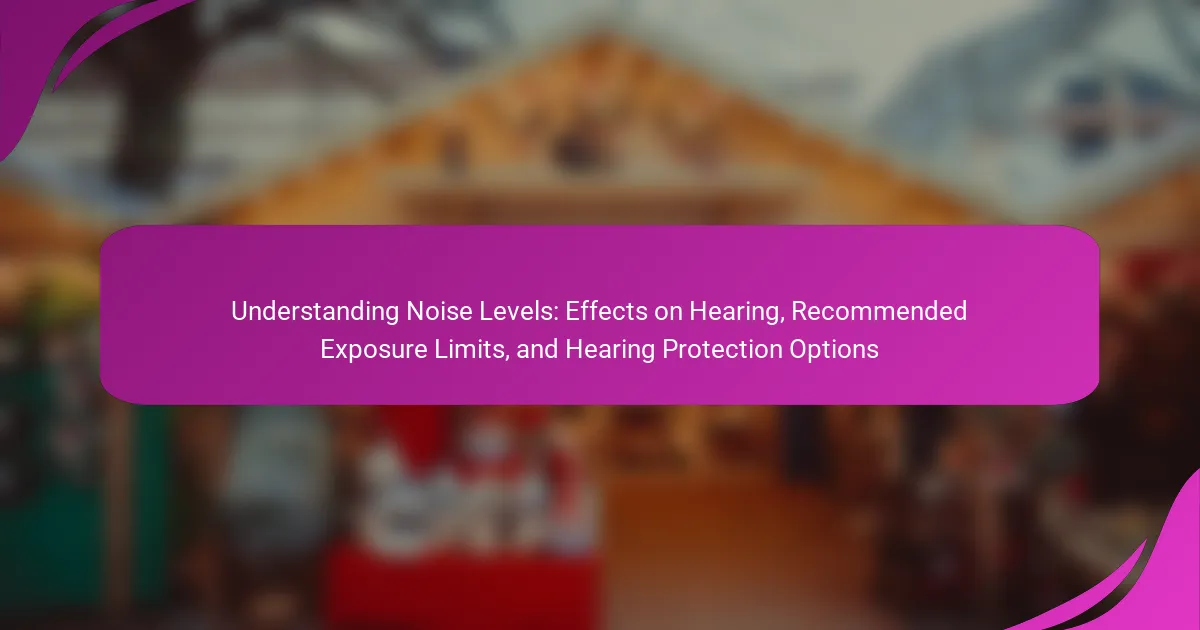Noise levels indicate the intensity of sound in an environment, measured in decibels (dB), with each 10 dB increase reflecting a tenfold rise in sound intensity. This article explores the measurement of noise levels using sound level meters, the application of A-weighting to assess perceived loudness, and the recommended exposure limits established by the Occupational Safety and Health Administration (OSHA) and the National Institute for Occupational Safety and Health (NIOSH) to prevent hearing loss. It also outlines various hearing protection options, such as earplugs, earmuffs, and custom-molded devices, emphasizing the importance of proper usage to mitigate the risks associated with prolonged exposure to high noise levels.

What are Noise Levels and How are They Measured?
Noise levels refer to the intensity of sound in a given environment, measured in decibels (dB). The decibel scale is logarithmic, meaning each increase of 10 dB represents a tenfold increase in sound intensity. Common noise levels include 30 dB for a quiet library and 120 dB for a jet takeoff.
Noise levels are measured using sound level meters, which capture sound pressure and convert it to a dB reading. These meters can be handheld devices or installed in fixed locations. The measurement process involves capturing sound over a specific period to account for fluctuations.
Additionally, A-weighting is often applied to mimic human hearing sensitivity, adjusting readings to reflect perceived loudness. This method is commonly used in occupational health assessments. According to the National Institute for Occupational Safety and Health (NIOSH), prolonged exposure to noise levels above 85 dB can lead to hearing loss.
What units are used to quantify noise levels?
Noise levels are quantified using decibels (dB). Decibels measure sound intensity on a logarithmic scale. This scale reflects the human ear’s response to sound. A change of 10 dB represents a tenfold increase in sound intensity. For example, normal conversation is around 60 dB. A sound level of 120 dB can cause immediate hearing damage. Understanding dB is essential for assessing noise exposure risks.
How does decibel scale work in measuring noise?
The decibel scale measures noise intensity logarithmically. It quantifies sound pressure levels relative to a reference level, typically 20 micropascals in air. Each increase of 10 decibels represents a tenfold increase in sound intensity. For example, 30 decibels is ten times more intense than 20 decibels. This scale allows for a wide range of sound levels to be represented. Common sounds range from a whisper at 30 decibels to a jet engine at 130 decibels. The logarithmic nature of the scale reflects human perception of sound, where a small change in decibels can correspond to a significant change in perceived loudness.
What are the different types of noise measurements?
The different types of noise measurements include sound pressure level (SPL), equivalent continuous noise level (Leq), peak sound level, and percentile noise levels. Sound pressure level quantifies the pressure variation in sound, measured in decibels (dB). Equivalent continuous noise level represents the average noise level over a specified period, reflecting fluctuating noise environments. Peak sound level captures the maximum sound pressure level during a noise event, crucial for assessing short bursts of noise. Percentile noise levels, such as L10 or L90, indicate the noise level exceeded for a certain percentage of the measurement period, providing insights into noise exposure variations. These measurements are vital for understanding noise impacts on hearing and setting exposure limits.
Why is it important to understand noise levels?
Understanding noise levels is crucial for protecting hearing health. High noise levels can lead to hearing loss and other auditory issues. Prolonged exposure to sounds above 85 decibels can cause permanent damage. The World Health Organization states that noise pollution affects millions globally. Understanding these levels helps in implementing safety measures. It also aids in compliance with occupational health regulations. Knowledge of noise levels can improve workplace environments. This understanding fosters awareness about the importance of hearing protection.
How do noise levels impact daily life?
Noise levels significantly impact daily life by affecting communication, concentration, and overall well-being. High noise levels can lead to difficulties in understanding speech, making conversations challenging. They can also disrupt focus, decreasing productivity in work or study environments. Prolonged exposure to excessive noise can contribute to stress, anxiety, and sleep disturbances. Research by the World Health Organization indicates that chronic noise exposure is linked to cardiovascular diseases and hearing loss. Additionally, noise pollution can affect social interactions and community relationships, leading to a decline in quality of life.
What are the sources of excessive noise in various environments?
Excessive noise in various environments primarily originates from industrial activities, transportation, and urban settings. Industrial machinery, such as compressors and generators, often produces high decibel levels. Construction sites contribute significant noise through heavy equipment and tools. Transportation sources include road traffic, airplanes, and trains, which generate continuous sound. Urban environments amplify noise due to population density and infrastructure. Additionally, social activities, including concerts and nightlife, can create loud environments. Studies indicate that prolonged exposure to noise levels above 85 decibels can lead to hearing loss.
What are the effects of noise on hearing?
Noise exposure can lead to hearing loss and other auditory effects. Prolonged exposure to loud sounds can damage the hair cells in the inner ear. This damage can result in temporary or permanent threshold shifts in hearing ability. Noise-induced hearing loss is often gradual and may not be immediately noticeable. The World Health Organization states that noise levels above 85 decibels can be harmful with prolonged exposure. Symptoms may include tinnitus, which is a ringing or buzzing in the ears. Hearing protection is essential in noisy environments to prevent these adverse effects. Regular hearing assessments can help monitor auditory health in individuals exposed to high noise levels.
What types of hearing loss are associated with high noise levels?
High noise levels are primarily associated with sensorineural hearing loss and temporary threshold shift. Sensorineural hearing loss occurs due to damage to the inner ear or auditory nerve. This type of hearing loss is often permanent and can result from prolonged exposure to loud sounds. Temporary threshold shift is a short-term reduction in hearing sensitivity after exposure to high noise levels. It typically resolves after a period of quiet. Research indicates that noise-induced hearing loss affects millions of individuals worldwide. The World Health Organization states that over 1 billion young people are at risk due to unsafe listening practices.
How does prolonged exposure to noise affect auditory health?
Prolonged exposure to noise adversely affects auditory health by causing hearing loss and auditory fatigue. Continuous high noise levels can damage hair cells in the cochlea, leading to permanent hearing impairment. The World Health Organization states that exposure to noise levels above 85 decibels for extended periods increases the risk of hearing damage. This damage can manifest as tinnitus, a ringing in the ears, and difficulty understanding speech. Additionally, chronic noise exposure may result in increased stress and anxiety, further impacting overall health. Regular monitoring of noise exposure and using hearing protection can mitigate these effects.

What are the Recommended Exposure Limits for Noise?
The recommended exposure limit for noise is 85 decibels (dB) for an 8-hour workday. This limit is set by the Occupational Safety and Health Administration (OSHA) to protect workers from hearing loss. Prolonged exposure to noise levels above this limit can lead to permanent hearing damage. For every increase of 3 dB, the permissible exposure time is halved. For example, at 88 dB, the exposure limit is reduced to 4 hours. At 91 dB, it further drops to 2 hours. These limits are based on extensive research demonstrating the risks associated with high noise exposure. The National Institute for Occupational Safety and Health (NIOSH) recommends an even lower limit of 85 dB for a 10-hour workday to enhance hearing protection.
What guidelines exist for safe noise exposure levels?
Guidelines for safe noise exposure levels are established by organizations like the Occupational Safety and Health Administration (OSHA) and the National Institute for Occupational Safety and Health (NIOSH). OSHA recommends a permissible noise exposure limit of 90 decibels (dB) for an 8-hour workday. For every 5 dB increase in noise level, the permissible exposure time is halved. NIOSH recommends a lower limit of 85 dB for an 8-hour exposure. They suggest using hearing protection when noise levels exceed this threshold. These guidelines aim to prevent hearing loss and maintain auditory health in noisy environments.
How do OSHA and NIOSH set their noise exposure limits?
OSHA and NIOSH set noise exposure limits based on scientific research and health data. OSHA establishes permissible exposure limits (PELs) through regulations that consider the risk of hearing loss. They rely on studies that assess the effects of noise on workers’ health. NIOSH recommends exposure limits by evaluating the latest scientific evidence on noise-induced hearing loss. Their recommended exposure limit (REL) is often lower than OSHA’s PEL to provide a margin of safety. Both organizations consider factors such as duration of exposure and intensity of noise. They also analyze epidemiological studies to understand long-term effects. This data-driven approach ensures that limits are protective of workers’ hearing health.
What factors influence recommended noise exposure limits?
Recommended noise exposure limits are influenced by several factors. These include the duration of exposure to noise, the intensity of the noise, and the frequency of the sound. The type of environment where exposure occurs also plays a significant role. Occupational settings may have different limits compared to residential areas. Individual susceptibility to noise-induced hearing loss varies among people. Age and pre-existing health conditions can affect sensitivity to noise. Regulatory guidelines from organizations like OSHA and NIOSH provide established limits based on extensive research. Studies show that prolonged exposure to noise above 85 dB can lead to permanent hearing damage.
How can individuals assess their noise exposure?
Individuals can assess their noise exposure by using sound level meters or noise dosimeters. Sound level meters measure the intensity of sound in decibels (dB) at a specific moment. Noise dosimeters track noise exposure over time, providing an average dB level.
Users can also consult guidelines from organizations like the Occupational Safety and Health Administration (OSHA). OSHA recommends monitoring noise levels regularly in environments with potential hazards.
Additionally, individuals can compare their exposure to recommended limits. The National Institute for Occupational Safety and Health (NIOSH) suggests a maximum exposure limit of 85 dB for an 8-hour workday.
Personal assessments can also include self-reporting symptoms such as ringing in the ears or difficulty hearing. These symptoms often indicate excessive noise exposure.
By combining these methods, individuals can effectively assess their noise exposure and take necessary precautions to protect their hearing.
What tools are available for measuring personal noise exposure?
Personal noise exposure can be measured using various tools. Sound level meters are commonly used for measuring environmental noise levels. Dosimeters are specialized devices that record noise exposure over time. Personal noise dosimeters can be worn on the body to capture real-time exposure levels. Smartphone applications are also available that estimate noise levels using built-in microphones. These tools help individuals monitor their exposure to potentially harmful noise levels. Accurate readings from these devices can inform users about their noise exposure and assist in protecting their hearing.
How can one determine if they are at risk for hearing damage?
To determine if one is at risk for hearing damage, individuals should assess their exposure to loud noises. Prolonged exposure to sounds above 85 decibels can lead to hearing loss. Common sources include heavy machinery, loud music, and firearms. Individuals should also consider their family history of hearing loss. Regular hearing tests can help identify any early signs of damage. Symptoms like ringing in the ears or difficulty understanding speech can indicate potential issues. The National Institute for Occupational Safety and Health (NIOSH) recommends monitoring noise levels in environments where exposure is likely.

What Hearing Protection Options are Available?
Hearing protection options include earplugs, earmuffs, and custom-molded devices. Earplugs are small devices inserted into the ear canal. They can reduce noise levels by 15 to 30 decibels. Earmuffs cover the entire outer ear. They typically provide a higher level of noise reduction than earplugs. Custom-molded devices are tailored to fit an individual’s ear shape. These options offer comfort and effective noise attenuation. The choice of protection depends on the noise level and duration of exposure. Proper use of these devices is essential for effective hearing protection.
What types of hearing protection devices exist?
There are several types of hearing protection devices. These include earplugs, earmuffs, and semi-insert earplugs. Earplugs are small devices inserted into the ear canal. They reduce noise exposure by blocking sound waves. Earmuffs cover the entire outer ear. They provide a seal around the ear to minimize noise. Semi-insert earplugs combine features of both earplugs and earmuffs. They sit partially in the ear canal while also having an outer covering. Each type varies in noise reduction ratings (NRR). The effectiveness of these devices depends on their design and fit. Proper usage of hearing protection devices can significantly lower the risk of hearing loss.
How do earplugs differ from earmuffs in terms of protection?
Earplugs provide sound isolation by sealing the ear canal, while earmuffs cover the entire ear. Earplugs typically offer a higher noise reduction rating (NRR) for certain frequencies. Earmuffs can be more effective for low-frequency noise due to their larger surface area. The choice between them depends on the noise environment. Research indicates that earplugs can reduce noise levels by 15 to 30 decibels. Earmuffs can offer similar or greater protection, especially in industrial settings. Proper fit is crucial for both to ensure maximum effectiveness.
What are the advantages of custom hearing protection?
Custom hearing protection offers several advantages. It provides a precise fit tailored to the individual’s ear shape. This ensures maximum comfort during extended use. A better fit also enhances sound isolation, effectively reducing harmful noise levels. Custom hearing protection can be designed for specific environments, such as industrial settings or musicians. This tailored approach improves overall effectiveness in noise reduction. Research indicates that custom devices can lead to higher compliance rates among users. Higher compliance means better protection against hearing loss.
How should one choose the right hearing protection?
To choose the right hearing protection, assess the noise level of the environment. Measure the noise in decibels (dB) using a sound level meter. Select hearing protection that offers a Noise Reduction Rating (NRR) suitable for the measured dB level. For example, if noise levels exceed 85 dB, use protection with an NRR of at least 15 dB. Consider the type of activity when selecting protection; earmuffs may be better for prolonged exposure, while earplugs can be more convenient for intermittent use. Ensure a proper fit for maximum effectiveness. Comfort and ease of use are also important factors. Studies show that properly selected hearing protection can significantly reduce the risk of hearing loss.
What factors should be considered when selecting hearing protection?
When selecting hearing protection, consider noise reduction rating (NRR), fit, comfort, and type. NRR indicates the level of sound reduction the device provides. A higher NRR offers better protection in louder environments. The fit of the hearing protection is crucial; it must create a proper seal to block noise effectively. Comfort affects wear time; uncomfortable devices may lead to inconsistent use. Different types, such as earmuffs and earplugs, serve various needs and environments. For example, earmuffs are suitable for intermittent loud noises, while earplugs are ideal for continuous exposure. Lastly, ensure the protection meets relevant safety standards for your specific industry.
How can comfort and fit affect the effectiveness of hearing protection?
Comfort and fit significantly impact the effectiveness of hearing protection. Properly fitted hearing protection creates an effective seal against noise. If the device is uncomfortable, users may not wear it consistently. Inconsistent use reduces overall noise reduction effectiveness. Studies show that discomfort leads to lower compliance rates. For example, a study by the National Institute for Occupational Safety and Health found that comfort is a key factor in user adherence. Additionally, a poor fit can allow sound to leak in, diminishing protection. Therefore, ensuring comfort and fit is essential for maximizing hearing protection efficacy.
What best practices can enhance hearing protection effectiveness?
Use high-quality hearing protection devices. These devices should meet safety standards such as ANSI or NIOSH certifications. Ensure a proper fit for maximum effectiveness. Ill-fitting devices can reduce noise attenuation significantly. Regularly inspect and maintain hearing protection equipment. Damaged or worn-out devices may not provide adequate protection. Educate users on the importance of consistent use in noisy environments. Studies show that consistent use can reduce hearing loss risk by up to 50%. Implement a hearing conservation program in workplaces. Such programs can promote awareness and proper usage of hearing protection.
How often should hearing protection be replaced or maintained?
Hearing protection should be replaced or maintained regularly to ensure effectiveness. Disposable earplugs should be discarded after each use. Reusable earplugs require cleaning and inspection before each use. Over-the-ear earmuffs should be checked for wear and tear every few months. If the cushioning becomes damaged or the seal is compromised, they should be replaced immediately. Regular maintenance ensures optimal noise reduction and comfort. Following manufacturer guidelines can provide specific timelines for replacement.
What are the common mistakes to avoid when using hearing protection?
Common mistakes to avoid when using hearing protection include not wearing it consistently in noisy environments. Users often underestimate noise levels, believing they can tolerate them without protection. Failing to select the appropriate type of hearing protection for specific noise levels is another mistake. Many people do not ensure a proper fit, which reduces effectiveness. Additionally, users might neglect to inspect their hearing protection for damage or wear. Some may also forget to replace disposable earplugs after use. Lastly, individuals sometimes ignore the need for training on how to use hearing protection correctly. These mistakes can lead to inadequate protection and increased risk of hearing loss.
Understanding noise levels is crucial for assessing their effects on hearing health and implementing effective protection measures. This article covers the definition and measurement of noise levels in decibels (dB), the types of noise measurements, and the impact of excessive noise on auditory health. It also outlines recommended exposure limits set by organizations like OSHA and NIOSH, factors influencing these limits, and various hearing protection options available to mitigate risks. Key insights into the importance of monitoring noise exposure and choosing the right hearing protection are also discussed, emphasizing best practices for maintaining auditory health.
